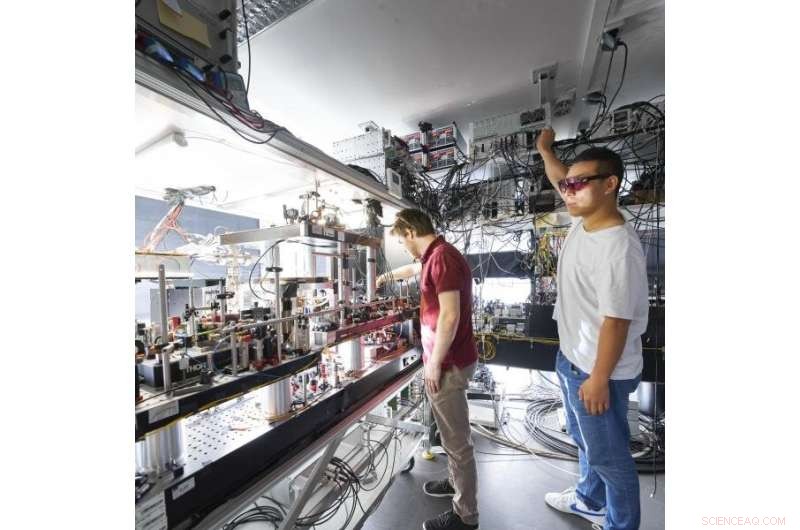
Schema del setup sperimentale. In ogni nodo, dislocato in edifici distanti 400 m, un unico 87 L'atomo Rb viene caricato in una trappola a dipolo ottico. Entrambi gli atomi sono eccitati in modo sincrono allo stato 5 2 P3/2 |F′=0, mF′ =0⟩ per generare entanglement atomo-fotone nel successivo decadimento spontaneo. I singoli fotoni emessi a una lunghezza d'onda di 780 nm vengono raccolti utilizzando obiettivi ad alta apertura numerica e accoppiati in fibre monomodali che portano ai dispositivi QFC. Lì, vengono convertiti in lunghezza d'onda di telecomunicazione (λ = 1.517 nm) per generazione di frequenza differenziale in una guida d'onda al niobato di litio (PPLN) a polo periodico situata in una configurazione di tipo interferometro Sagnac, tale configurazione mantiene completamente lo stato quantico di polarizzazione del fotone. I fotoni convertiti sono guidati verso una stazione intermedia da collegamenti in fibra con lunghezze fino a 16,5 km, dove l'entanglement viene scambiato con gli atomi da un BSM. Dopo aver generato con successo l'entanglement atomo-atomo, gli atomi vengono analizzati indipendentemente da un impulso di lettura di cui la polarizzazione, impostata da una piastra a semionda (HWP) e una piastra a quarto d'onda (QWP), definisce l'impostazione di misurazione. PC, controller di polarizzazione. Credito:Natura (2022). DOI:10.1038/s41586-022-04764-4
Una rete in cui la trasmissione dei dati è perfettamente sicura contro l'hacking? Se i fisici avranno la loro strada, questo diventerà realtà un giorno con l'aiuto del fenomeno della meccanica quantistica noto come entanglement. Per le particelle entangled, la regola è:se si misura lo stato di una delle particelle, si conosce automaticamente lo stato dell'altra. Non fa differenza quanto siano lontane le particelle aggrovigliate l'una dall'altra. Questo è uno stato di cose ideale per trasmettere informazioni su lunghe distanze in un modo che rende impossibile l'intercettazione.
Un team guidato dai fisici Prof. Harald Weinfurter della LMU e Prof. Christoph Becher della Saarland University hanno ora accoppiato due memorie quantistiche atomiche su una connessione in fibra ottica lunga 33 chilometri. This is the longest distance so far that anyone has ever managed entanglement via a telecom fiber.
The quantum mechanical entanglement is mediated via photons emitted by the two quantum memories. A decisive step was the researchers' shifting of the wavelength of the emitted light particles to a value that is used for conventional telecommunications. "By doing this, we were able to significantly reduce the loss of photons and create entangled quantum memories even over long distances of fiber optic cable," says Weinfurter.
Generally speaking, quantum networks consist of nodes of individual quantum memories—such as atoms, ions, or defects in crystal lattices. These nodes are able to receive, store, and transmit quantum states. Mediation between the nodes can be accomplished using light particles that are exchanged either over the air or in a targeted manner via fiber optic connection. For their experiment, the researchers use a system comprised of two optically trapped rubidium atoms in two laboratories on the LMU campus. The two locations are connected via a 700-meter-long fiber optic cable, which runs underneath Geschwister Scholl Square in front of the main building of the university. By adding extra fibers on coils, connections of up to 33 kilometers in length can be achieved.
A laser pulse excites the atoms, after which they spontaneously fall back into their ground state, each thereby emitting a photon. Due to the conservation of angular momentum, the spin of the atom is entangled with the polarization of its emitted photon. These light particles can then be used to create a quantum mechanical coupling of the two atoms. To do this, the scientists sent them through the fiber optic cable to a receiver station, where a joint measurement of the photons indicates an entanglement of the quantum memories.

Credit:Jan Greune
However, most quantum memories emit light with wavelengths in the visible or near-infrared range. "In fiber optics, these photons make it just a few kilometers before they are lost," explains Christoph Becher. For this reason, the physicist from Saarbrücken and his team optimized the wavelength of the photons for their journey in the cable. Using two quantum frequency converters, they increased the original wavelength from 780 nanometers to a wavelength of 1,517 nanometers.
"This is close to the so-called telecom wavelength of around 1,550 nanometers," says Becher. The telecom band is the frequency range in which the transmission of light in fiber optics has the lowest losses. Becher's team accomplished the conversion with an unprecedented efficiency of 57%. At the same time, they managed to preserve the quality of the information stored in the photons to a high degree, which is a condition of quantum coupling.
"The significance of our experiment is that we actually entangle two stationary particles—that is to say, atoms that function as quantum memories," says Tim van Leent, lead author of the paper published in Nature . "This is much more difficult than entangling photons, but it opens up many more application possibilities."
The researchers think that the system they developed could be used to construct large-scale quantum networks and for the implementation of secure quantum communication protocols. "The experiment is an important step on the path to the quantum internet based on existing fiber optic infrastructure," says Harald Weinfurter. + Esplora ulteriormente